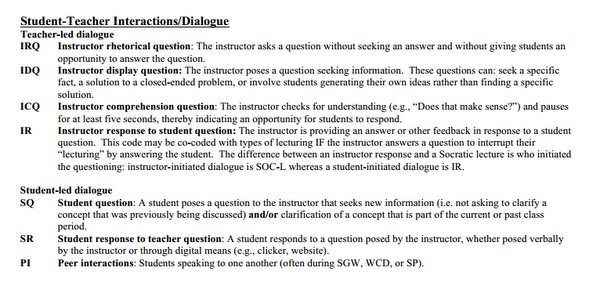Developed by Matthew T. Hora and Joseph J. Ferrare
| Purpose |
To document teaching practice, support professional development, evaluate effects of instructional interventions and specify teaching practices that distinguish between control & experimental conditions.
|
|---|---|
| Format | Observation protocol |
| Duration | N/A min |
| Focus | Teaching |
| Level | Graduate, Upper-level, Intermediate, Intro college, High school, Middle school, Other |
Example TDOP codes:

The developers of the TDOP have created an in-depth user guide with many important instructions and details for using the TDOP.
more details
This is the highest level of research validation, corresponding to all seven of the validation categories below.
Research Validation Summary
Based on Research Into:
- Classroom behavior
Studied Using:
- Iterative observations
- Inter-rater reliability
- Training materials
Research Conducted:
- At multiple institutions
- By multiple research groups
- Peer-reviewed publication
The codes and categories on the TDOP were developed based on an instrument designed to study inquiry-based middle school sciences courses. The developers then identified five key aspects of classroom dynamics and adapted codes from these categories from the original instrument. The codes were tested in classrooms and underwent expert review. The developers created a rigorous training program, which was completed by 56 raters from several disciplines. The raters completed iterative observations where they observed classes across 4 disciplines, calculated inter-rater reliability, and completed more observations until sufficient inter-rater reliability was achieved. There are over 8 peer-reviewed publications about the TDOP.
References
- J. Ferrare and M. Hora, Cultural Models of Teaching and Learning in Math and Science: Exploring the Intersections of Culture, Cognition, and Pedagogical Situations, J. Higher Educ. 85 (6), 792 (2014).
- S. Franklin and T. Chapman, Diversity of Faculty Practice in Workshop Classrooms, presented at the Physics Education Research Conference 2012, Philadelphia, PA, 2012.
- M. Hora, Toward a Descriptive Science of Teaching: How the TDOP Illuminates the Multidimensional Nature of Active Learning in Postsecondary Classrooms, Sci. Educ. 99 (5), 783 (2015).
- M. Hora, Exploring the Use of the Teaching Dimensions Observation Protocol to Develop Fine-grained Measures of Interactive Teaching in Undergraduate Science Classrooms, 2013.
- M. Hora and J. Ferrare, Remeasuring Postsecondary Teaching: How Singular Categories of Instruction Obscure the Multiple Dimensions of Classroom Practice, J. Coll. Sci. Teaching 43 (3), 36 (2014).
- M. Hora and J. Ferrare, Instructional Systems of Practice: A Multidimensional Analysis of Math and Science Undergraduate Course Planning and Classroom Teaching, J. Learn. Sci. 22 (13), 212 (2012).
- M. Hora, A. Oleson, J. Bouwma-Gearhart, and J. Collins, Findings from an administration of the ISOP framework at Institution A in the Spring of 2013: Insights into course planning, classroom teaching, and student experiences in STEM courses, 2013.
- A. Oleson and M. Hora, Teaching the way they were taught? Revisiting the sources of teaching knowledge and the role of prior experience in shaping faculty teaching practices, Int. J. Higher Educ. Res. 68 (1), 29 (2014).
- M. Wilcox, G. Feldman, J. Von Korff, N. Klinger, O. Sengul, and J. Chini, Characterizing Studio Physics Instruction Across Instructors and Institutions, presented at the Physics Education Research Conference 2016, Sacramento, CA, 2016.
We don't have any translations of this assessment yet.
If you know of a translation that we don't have yet, or if you would like to translate this assessment, please contact us!
| Typical Results |
|---|
Results from the TDOP are only a measure of what is happening in the classroom and not a rating of it. Instructors can use the results in combination with something like the Reformed Teaching Observation Protocol (RTOP) to see both a rating of your instruction and what exactly you are doing during class to help you improve. Also, many of the items on the TDOP are representative of practices that are known to generally be "better" or "worse" methods so the time spent on these items as shown in the TDOP results could show room for improvement. |
The latest version of the TDOP, released in 2015, is version 2.1. Version 1.0 was developed in 2009 and version 2.0 was released in 2014.



